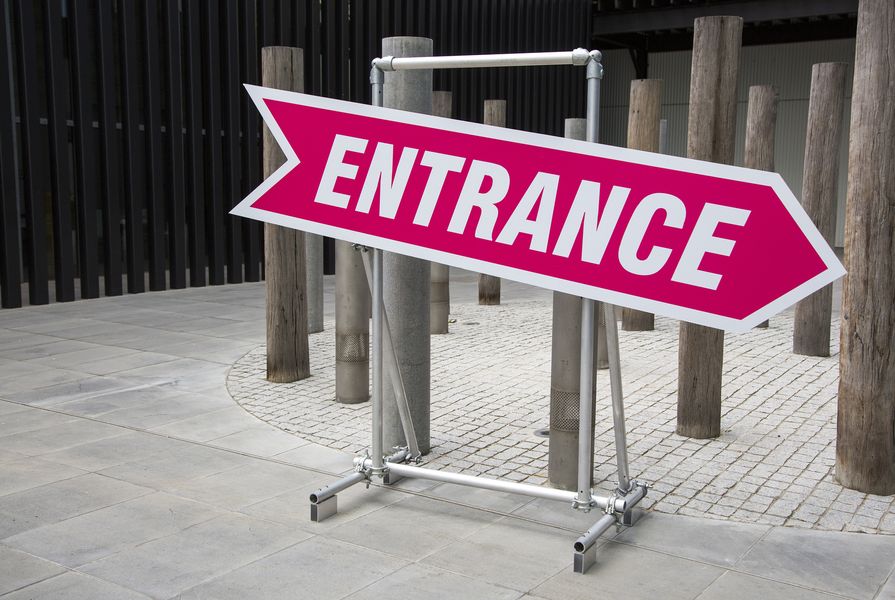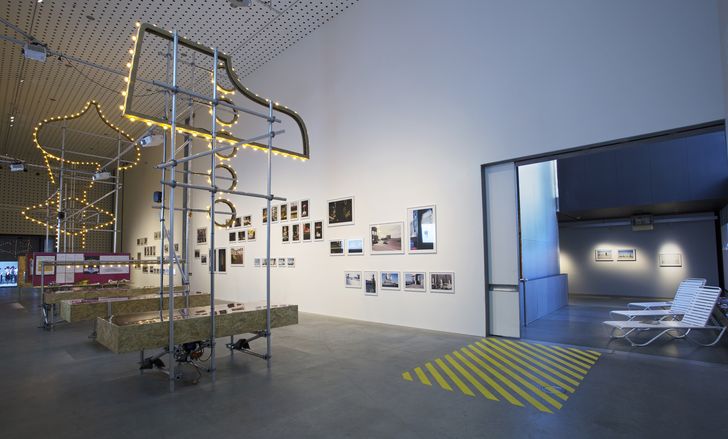The exhibition Las Vegas Studio documents the seminal research of American architects Robert Venturi and Denise Scott Brown into the architecture of Las Vegas. Its April 2014 installation at the RMIT Design Hub in Melbourne, an ambitious and largely successful exercise designed by Searle X Waldron Architecture and curated by Fleur Watson, also traced the influence of Venturi and Scott-Brown’s work on Melbourne-based practitioners. This was in itself a postmodern task: to do more than one thing at a time, an “and” rather than an “or.” The exhibition was in fact two shows: Las Vegas Studio: Images from the Archives of Robert Venturi and Denise Scott Brown – a travelling exhibition first developed by the Museum im Bellpark Kriens and curated by Hilar Stadler and Martino Stierli, augmented for its Melbourne appearance to become a bigger, more locally specific installation – and John Gollings: Learning from Surfers Paradise, an exhibition of photographs taken by this leading architectural photographer. The contents of both exhibitions are connected – the famous book Learning from Las Vegas is the subject of the main exhibition, but the same ability to describe a place, particularly through photographs, is seen in Gollings’s study of Queensland’s Surfers Paradise (a location akin in some ways to Nevada’s desert city).
The Melbourne installation was designed by Searle X Waldron Architecture and curated by Fleur Watson.
Image: Tobias Titz
As a title, Learning from Las Vegas strongly suggests a text that engages with a place, rather than importing ideas into it. The Las Vegas Studio was of course a 1968 design studio led by Venturi, Scott Brown and Steven Izenour with students from Yale University, which then informed the 1972 book, Learning from Las Vegas. We know of the book more than the studio, but it is important to note that this research started as a studio, an observation which explains to some extent its investigational and propositional nature. So what did we learn from Learning from Las Vegas? It’s not the description of Vegas, which has changed enormously since 1968, but rather how to learn from a place. What we really learnt was how to “see.”
The exhibition was scattered across the main subterranean gallery, circulation and foyer spaces of the Design Hub. The embrace of signs as both exhibition objects and wayfinding worked well in a building dedicated to absence – they seemed to complete the building for a moment, to bring it into the familiar. The main gallery was the centrepiece and this show exploited its remarkably high ceiling height adeptly: the “main attractions” were the large, light globe-encrusted frameworks of key Las Vegas signs as they appeared in Learning from Las Vegas. These were signs of signs.
Three white plastic sun-loungers sat at the southern end of the main gallery, a statement about the everyday (and inspired by one of the exhibited photographs) but also somewhere to sit and read copies of Learning and others related texts. Local firms whose work was influenced by Venturi and Scott-Brown included Edmond & Corrigan, Lyons and Ashton Raggatt McDougall (ARM). Edmond & Corrigan are often seen as the developers of a postmodern architecture in Australia, and the links are strong in terms of approach if not aesthetic. Closer perhaps is the work and practice model of Lyons – founding director Corbett Lyon worked for what later became the large commercial practice of Venturi Scott Brown and Associates (VSBA) and studied under Steve Izenour, the often-overlooked third author of Learning. In the 1990s, ARM tested the limits of the referential with a built transformation of the Vanna Venturi House, the Howard/Kronberg Medical Clinic, and both this and the rich populist object models of ARM’s Ian McDougall made their way suitably into the show. Other elements in the mix included Las Vegas: Melbourne, a new film by Nervegna Reed (produced in a similar style to the excellent Dr Caligari Moves to the Suburbs: The Architecture of Edmond & Corrigan of 2013), which rolled over the expansive western white wall. The exhibited objects, books and models were protected in new OSB boxes, which, coupled with the large “sign-signs,” dissected the voluminous space.
John Gollings: Learning from Surfers Paradise, a body of work inspired by Venturi and Scott Brown’s observations of Las Vegas.
Image: Tobias Titz
John Gollings’s salon of photographs, first developed by the Gold Coast City Gallery with Gollings Studio and curated by Virginia Rigney, was exhibited in the ramped entry space that runs parallel to the footpath. It’s a layered space into which the exhibition introduced large OSB chevrons onto the galvanized steel web forge walling, in part to assist with the hanging of work and to add a super graphic “sign.” The photographs are a forty-year study of Surfers Paradise: contrasting images from now and then that describe a part of Australia that has undergone massive change in recent decades. This project alone is now a vitally important historical document, just one part of this photographer’s remarkable contribution to ways of “seeing.” As with its partner exhibition, this installation just made the Design Hub building better – and this space has become an active exhibition space for this and other shows.
“Signs of signs” dissected the voluminous spaces of the building.
Image: Tobias Titz
The beauty of postmodernism is its ability to layer, to reference again and again, to question and de-author the source and to emphasize the operation over the subject. There is a very Melbourne vein of “PoMo,” both derided and celebrated. The movement came to Melbourne through the architects featured in this exhibition, others returning from working internationally and colour publications such as AD. It found a critical home in Melbourne, thanks in particular to its ability to challenge and its tendency to support a multiplicity of ideas rather than one pure essence. Exhibition designers Searle X Waldron are themselves becoming a part of this rich Melbourne history of engagement. The studio’s exhibition design is incredibly well matched to its content, well described and argued for. The wonderful drawings for the exhibition are a treat in themselves – elevating those photographs, scheduling those signs. These young exhibition designers have demonstrated both a respectful knowing and a deep understanding of the content.
The legacy of Learning from Las Vegas is the close examination of a particular condition and Venturi and Scott Brown’s value-free approach to assessing the city as they found it. Peter Corrigan touched on this in his typically witty and insightful short piece of writing in the catalogue, which discussed “an architecture of identity, alive to a vernacular.” This strategic examination of things is an appropriate approach to architecture, and in this regard the exhibition was both didactic and a signifier; a lesson learnt.


























